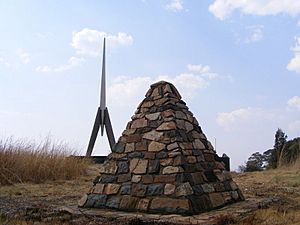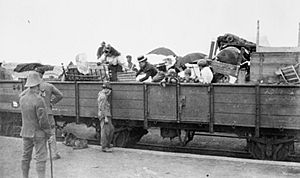Belfast, Mpumalanga facts for kids
Quick facts for kids
Belfast
|
|
|---|---|
| eMakhazeni | |

Battle of Berg-en-dal Memorial south of Belfast.
|
|
| Country | South Africa |
| Province | Mpumalanga |
| District | Nkangala |
| Municipality | Emakhazeni |
| Area | |
| • Total | 35.82 km2 (13.83 sq mi) |
| Population
(2011)
|
|
| • Total | 4,466 |
| • Density | 124.679/km2 (322.92/sq mi) |
| Racial makeup (2011) | |
| • Black African | 39.9% |
| • Coloured | 4.4% |
| • Indian/Asian | 2.6% |
| • White | 52.6% |
| • Other | 0.5% |
| First languages (2011) | |
| • Afrikaans | 57.1% |
| • Zulu | 12.3% |
| • Swazi | 7.6% |
| • English | 6.9% |
| • Other | 16.0% |
| Time zone | UTC+2 (SAST) |
| Postal code (street) |
1100
|
| PO box |
1100
|
| Area code | 013 |
Belfast, also known as eMakhazeni, is a small town in the Mpumalanga Province of South Africa. It is part of the eMakhazeni Local Municipality.
This town is famous for its great trout fishing. Farmers here raise sheep and produce dairy products. They also grow crops like maize, potatoes, and timber. The area around Belfast has mines for coal and black granite. About 6 million tulip bulbs are grown here each year and sent to other countries. Belfast is very high up, at 2,025 meters (6,644 feet) above sea level. This makes it one of the coldest and highest towns in South Africa.
Contents
Discovering Belfast's Name
The town was named after Richard Charles O'Neil. He came from Belfast, Northern Ireland. Richard O'Neil owned the farm where the town was later built.
A Look at History
Belfast and the Anglo-Boer War
During the Anglo-Boer War, many battles and small fights happened in and around Belfast. One important fight was the Battle of Leliefontein. It took place about 30 kilometers (19 miles) south of the town. Canadian soldiers received special awards called Victoria Crosses for their bravery there.
The British army also built a camp in Belfast during the war. This camp housed Boer women and children. Another important event happened at Monument Hill, near the town. Several more Victoria Crosses were given for actions there.
The Battle of Bergendal
The Battle of Bergendal was a major fight during the war. It happened along the railway line east of Belfast. This battle lasted from August 21 to August 27, 1900. About 7,000 Boer soldiers fought under General Louis Botha. Their main camp was at a railway station called Dalmanutha.
The British forces had about 19,000 soldiers. They were led by Lord Roberts. General Sir Redvers Buller led the final attack. This attack was against the Boer position on a farm called Berg-en-dal, which means "Hill-and-dale."
Exploring Belfast's Geography
Belfast's Climate
Belfast has a climate known as a subtropical highland climate. This means it has mild summers and cold, dry winters. On average, the town gets about 674 millimeters (26.5 inches) of rain each year. Most of this rain falls during the summer months.
| Climate data for Belfast, Mpumalanga (1961–1990) | |||||||||||||
|---|---|---|---|---|---|---|---|---|---|---|---|---|---|
| Month | Jan | Feb | Mar | Apr | May | Jun | Jul | Aug | Sep | Oct | Nov | Dec | Year |
| Record high °C (°F) | 31 (88) |
30 (86) |
28 (82) |
30 (86) |
25 (77) |
24 (75) |
26 (79) |
26 (79) |
31 (88) |
32 (90) |
31 (88) |
31 (88) |
32 (90) |
| Mean daily maximum °C (°F) | 23 (73) |
22 (72) |
22 (72) |
20 (68) |
18 (64) |
15 (59) |
16 (61) |
18 (64) |
22 (72) |
22 (72) |
22 (72) |
23 (73) |
20 (68) |
| Mean daily minimum °C (°F) | 12 (54) |
12 (54) |
11 (52) |
8 (46) |
4 (39) |
1 (34) |
1 (34) |
3 (37) |
6 (43) |
8 (46) |
10 (50) |
11 (52) |
7 (45) |
| Record low °C (°F) | 1 (34) |
1 (34) |
0 (32) |
−3 (27) |
−4 (25) |
−7 (19) |
−6 (21) |
−8 (18) |
−4 (25) |
−3 (27) |
1 (34) |
2 (36) |
−8 (18) |
| Average precipitation mm (inches) | 170 (6.7) |
101 (4.0) |
83 (3.3) |
53 (2.1) |
16 (0.6) |
7 (0.3) |
5 (0.2) |
9 (0.4) |
33 (1.3) |
93 (3.7) |
156 (6.1) |
152 (6.0) |
878 (34.6) |
| Average precipitation days (≥ 1.0 mm) | 13 | 10 | 9 | 6 | 3 | 1 | 1 | 2 | 3 | 9 | 13 | 13 | 83 |
| Source: South African Weather Service | |||||||||||||
Town Infrastructure
Belfast has a railway station. This station is used to load and unload both people and goods. It is part of the Pretoria–Maputo railway line.




